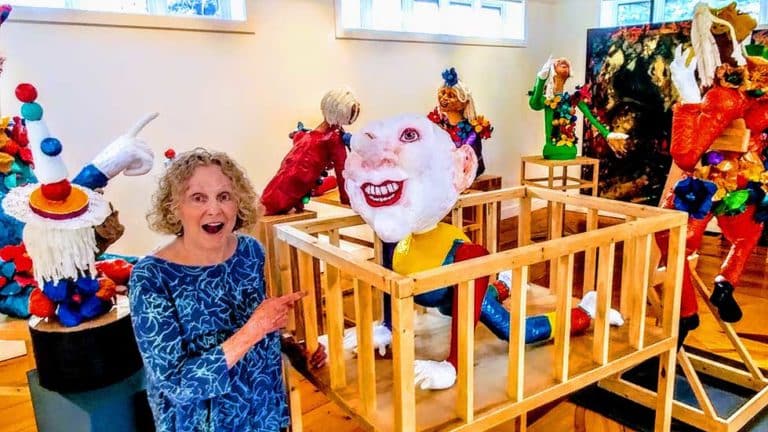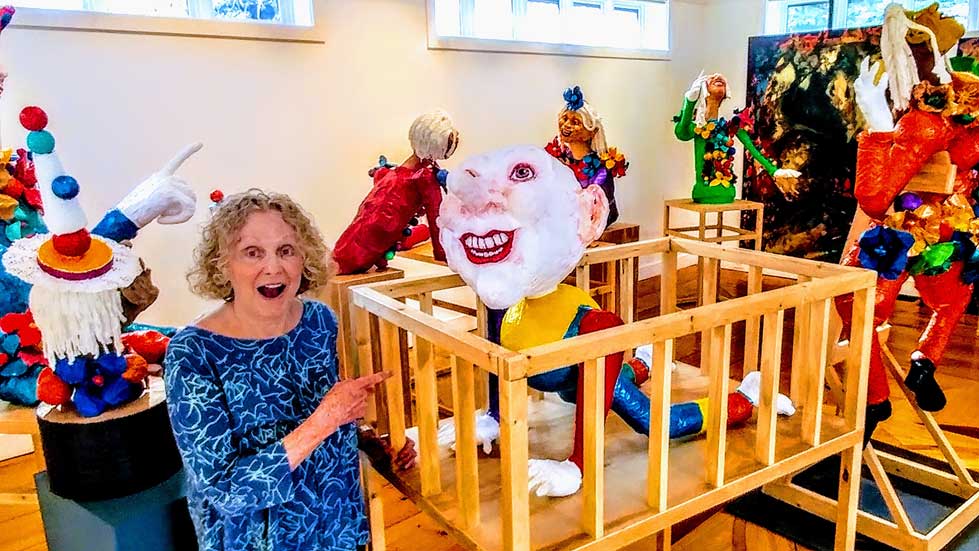

Walking into Fran Bull’s Brandon studio is like entering a fantasy world. Imaginative characters pop up and greet visitors with smiles, leers and bright colors. Inspired by the commedia dell’arte, a theater form originating in 16thcentury Italy, they almost feel like visitors from that time. Her piece “A Fool is Born” was recently included in the inaugural exhibit organized by Bill Ramage at Rutland’s new 77 Gallery. After graduating from Bennington College, Bull came of age in bohemian New York in the 1960s through the mid '80s. She was then known as a photo-realist painter, and gradually developed her ingenious artistic voice, one that incorporates both painting and sculpture. Her remarkable series, “Stations,” depicting many nuances of a life’s journey, which premiered at both the Chaffee Downtown Gallery and the Castleton Downtown Gallery, has now traveled to the Venice Biennale in Italy.
Bull’s art has always been strongly influenced by European traditions. As a child, she lived in post-war Vienna where her father was an Associated Press journalist covering the Nuremberg War Trials. I was intrigued by this early exposure to Europe when I wrote the introduction for her exhibit at Spazio LOA in Milan, Italy in the fall of 2017. Dr. Giorgio Grasso, a curator for the Venice Biennale, invited her to show “Stations” at the Palazzo Zenobia, located on Venice’s Grand Canal. I’m fascinated with her journey from Vermont to Venice, and would like to ask her a few questions about these connections. It’s no accident that she has been using Venetian plaster for years to create her larger-than-life-size figures, and that these very figures have made their way back to their origins in the 57th Venice Biennale.
In Italian, we would call that “destino” — destiny — which is always working behind the scenes and reveals itself in the most unexpected ways.
BA: Your work has a very theatrical quality to it. Could you share a bit about how that influence evolved in your painting and sculpture?
FB: I have loved theater and opera since childhood, which probably explains my seeing the world and its inhabitants in theatrical terms. The whole world becomes exaggerated and vivid. I fixate on this one’s wild hair, that one’s animated facial expression or fascinating clothing. I remember going backstage and meeting Dick Deadeye, the scary pirate from “H.M.S. Pinafore.” It was thrilling to have Dick Deadeye all to myself, still wearing his make-up. I was seven when I was taken to the opera in Vienna. This was one of those life-defining moments. I heard the operatic voice as something enchanting and otherworldly, I wanted nothing more than to know how to make those sounds. I study singing to this day.
BA: What was it like being included in the Venice Biennale?
FB: Showing at the Venice Biennale was exciting and crazy making. The wild ride began at the opening of a show I had in Milan at Spazio LOA. I see a man approaching me with great urgency. He is carrying a catalog of the sculpture series “Stations,” exhibited previously — and equally raucously — in Rutland. I didn’t know it, but he was Dr. Giorgio Grasso, an art curator at the Venice Biennale. He showered the art with compliments and then invited me to show “Stations” at the Biennale. Stunned, incredulous, I said, “Yes — of course!” That was just the beginning. How to ship three very large, heavy crates of art to Venice in time for installation and an opening? One November 2017 morning, two gigantic tractor-trailer trucks from an international shipper in New York, arrived at my barn to pick up the art. The crew loaded the crates, looked around in awe at the Vermont landscape, and in no time disappeared down the road. Soon after, architect Robert Black, my partner and installation designer, and I flew to Venice. Venice is a city of waterways. The streets are narrow canals. The art arrived at the Palazzo Zenobio on a very small watercraft, with crates hanging over the sides. I only know this from Robert’s photos because I crouched upstairs in the Palazzo, covering my eyes, unable to watch as four or five strong men lifted crates from the boat and hefted them up the narrow staircase to the exhibition gallery. Crates were opened, the heavy pieces placed on the floor and then the shippers left. With only two hours to the opening, where the heck was the team needed to install? Robert dashed to a hardware store, just about to close, and bought some special bolts for the stone walls. Someone brought in a rickety ladder, surely a relic from the 15th century. I stood in the space, gazing down at the heavy pieces, chewing my fingernails. Then something miraculous happened. I could hear heavy footsteps like an army marching down the long hall towards my gallery. Appearing at the door was the beaming curator himself, Dr. Grasso, and with him were six strong men, some in work clothing, others in business suits. The team had arrived! With much laughter and banter, the work was hoisted up onto the walls. In that moment I learned something important from the Italians about time and faith.
BA: Is living in Vermont an important part of your creative process?
FB: I need the calm beauty of the countryside and I need the stimulation of New York City. I came to Vermont 18 years ago imagining I’d be a hermit. As soon as I arrived, my life changed radically. I think my city life was actually more hermit-like. When I opened Gallery-in-the-Field a dream was realized, and suddenly I became a member of a wonderful, lively, enthusiastic arts community, one that extended to the whole of Vermont.
BA: What’s the tie-in between your Vermont life and your connections to Europe?
FB: As for my life in Europe, I’ve been making etchings for 18 years in Barcelona with Virgili Barbara, master printer. His workshop is a cherished retreat. I mainly speak Spanish, work long hours, share an abundant midday meal each day with Virgili’s family, enjoy the company of dear artist friends. I visit museums and galleries. You could say I step into another skin for a time, see life from another perspective. I am refreshed.
BA: You have always been a great supporter of the arts. So many artists are interested only in their own careers. Why is this art advocacy important to you?
FB: My “life in art” includes an enthusiasm for all aspects of art and art making. I delight in an encounter with the art of others — living or dead, neighbor or stranger — found in a gallery or museum or in a studio. When I ran the gallery, I loved introducing artists and presenting their art and ideas to the community. It feels natural to me to support arts institutions whose important mission is often underfunded in today’s climate. Art is a vast vessel, or container, for the human soul’s outpouring. Art, in fact, may be viewed as the very soul of humankind made visible. How can art’s value to our collective civilizations and to our history on the planet, not be of prime importance?
https://www.rutlandherald.com/the-artist-s-voice-fran-bull-from-vermont-to-venice/